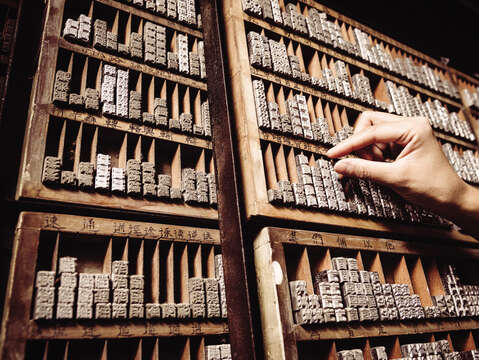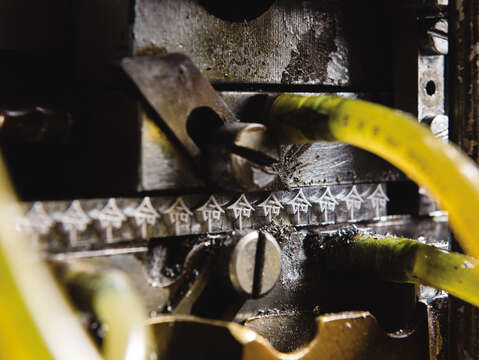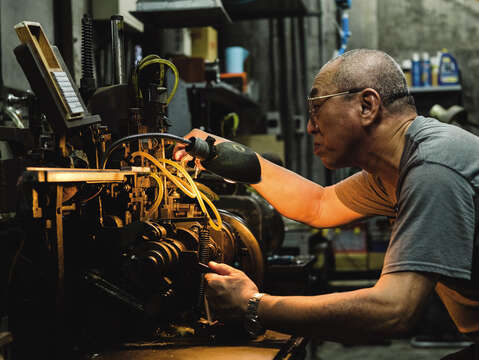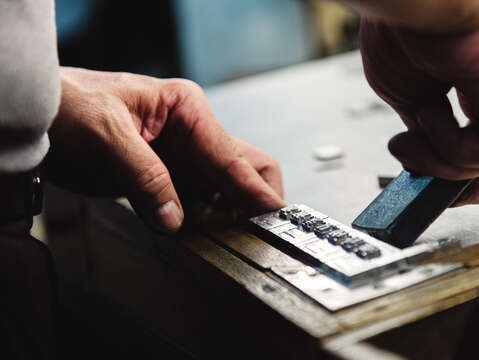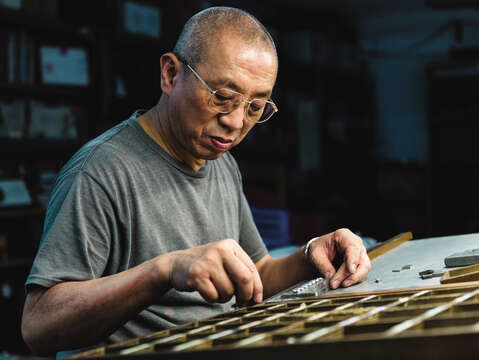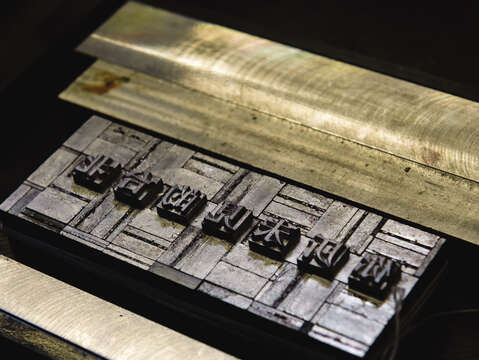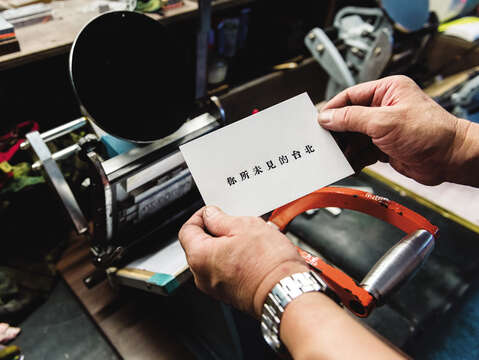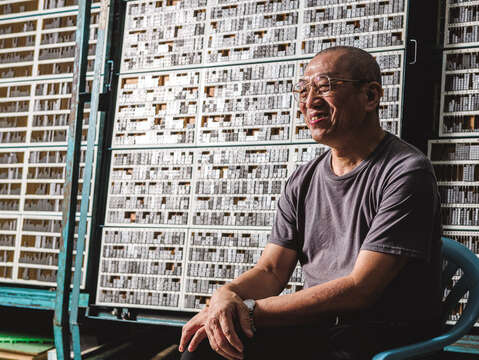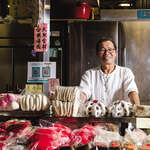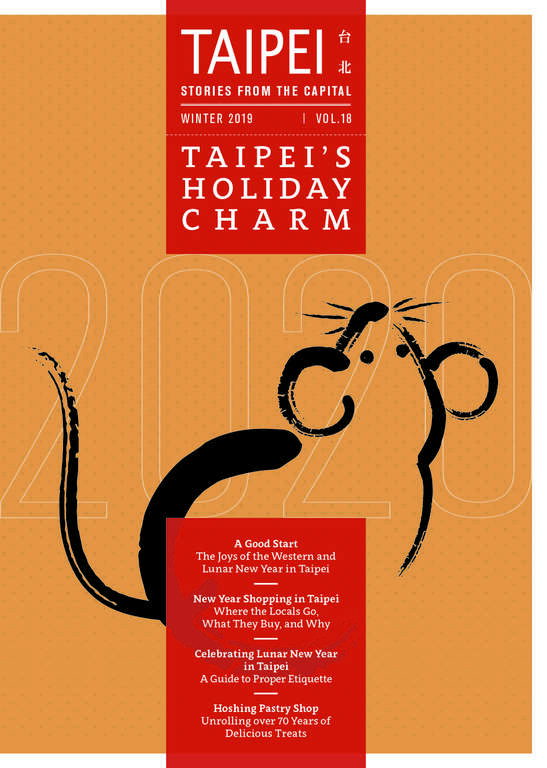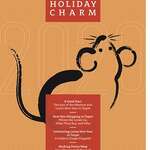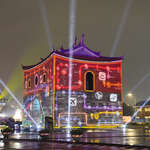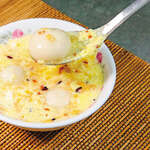Post date:2019-12-12
2432
TAIPEI #18 (2019 Winter)
Ri Xing Type Foundry: Fresh Impressions of a Fading Legacy
Photos by Yi Choon Tang
Located on a quiet alley off a bustling street near Taipei Main Station lies a storefront that looks largely untouched since the 1960s, Ri Xing Type Foundry (日星鑄字行). The owner, Zhang Jieguan (張介冠), cheerfully appears at the door, probably accustomed to having visitors walk right up to the entrance out of sheer curiosity. He welcomes TAIPEI in, and immediately we stand at the door gaping at towering aisle after aisle of Chinese lead type characters awaiting us inside. Every Chinese character you could ever imagine has been packed tightly in neatly-stacked rows based on radicals (部首) or common phrases. And as if the first floor wasn’t astounding enough, we follow Zhang down the steps leading to a basement filled with yet even more rows of lead type characters. What is this place and how did Zhang singlehandedly bear such a large undertaking?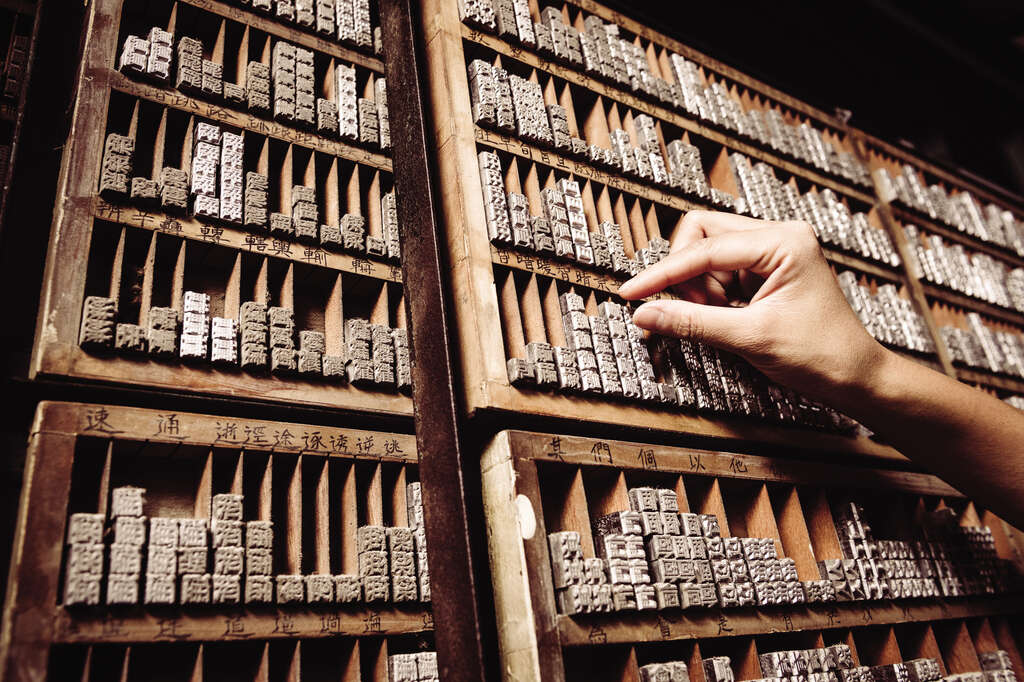
▲When you enter Ri Xing Type Foundry, the first thing that comes into view are the lead character types packed tight in neatly-stacked rows.
A FADING TRADITION STANDING STILL IN TAIPEI
The origins of letterpress printing can actually be traced as far back as the mid-15th century in Germany to Johannes Gutenberg. At a time when all manuscripts were written painstakingly by hand, letterpress printing was an efficient form of printing that could produce as much as six pages a day. By locking movable type into a “bed” and adding a layer of ink, the ink from the type would be pressed firmly onto the sheet of paper, leaving a deep impression of words on the sheet. Not only did this technology pave the way for the future of computer printing, but it also made information more accessible to a wider audience at the time. The letterpress printing industry thrived in Taipei from the 1950s and supported a then blooming publishing industry, witnessing the rise of the Economic Miracle period in Taiwan.
Although a late player to the game — Ri Xing was established in 1969 near the tail end of the industry’s peak — today it is arguably the last standing Traditional Chinese type foundry in the entire world. Having seen shop after shop close down in the early 2000s, Zhang bravely made up his mind to keep his shop going, not wanting to see this traditional method of letterpress printing die out. But for a language like Chinese with over 50,000 characters, this unprecedented, almost unheard-of scale is one even Gutenberg himself could never have imagined!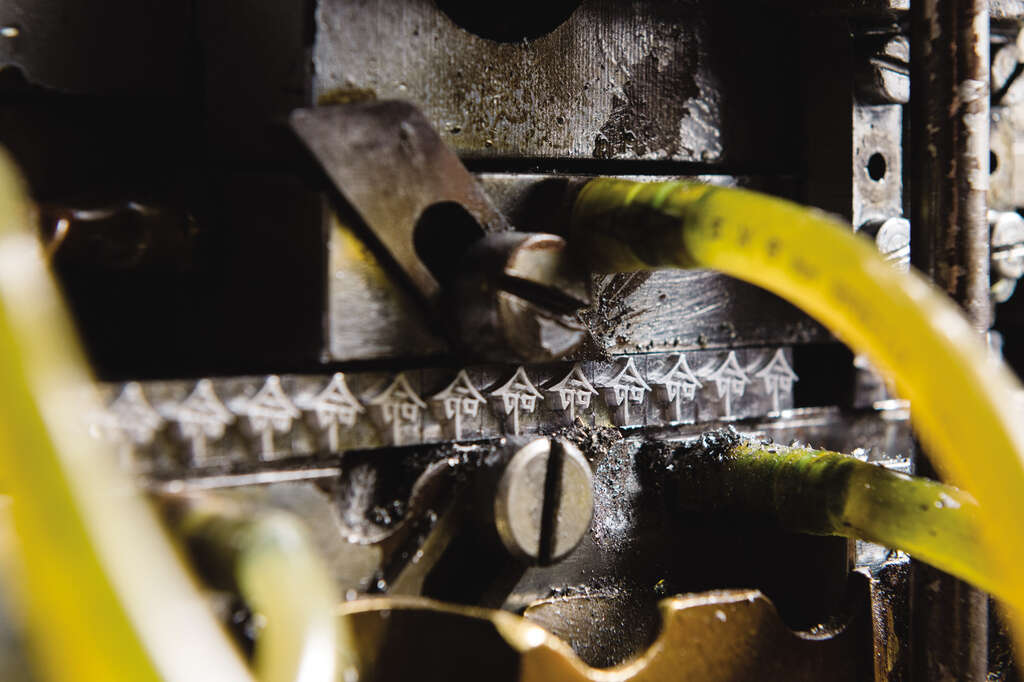 ▲After the temperature reaches 300 degrees Celsius, the machine then cranks out 10 characters at a time.
▲After the temperature reaches 300 degrees Celsius, the machine then cranks out 10 characters at a time.
HOW LEAD CHARACTER TYPES ARE CAST
In order to create lead character types, lead must be added to a heated pot in a machine, boiled to 300 degrees Celsius, and then released using a plunger that forces the liquid metal into a mold, casting the correct character. The machine Zhang demonstrates for us cranks out 10 characters at a time. Just how heavy can these characters get? “Well, lead is 13.6 times heavier than water. So, for the largest character, it’s about 20 characters per kilogram. And for the smallest one, it’s about 644 characters,” Zhang replies matter-of-factly.
In terms of Chinese typefaces, Ri Xing produces only three kinds: Kaiti (楷體), Songti (宋體), and Heiti (黑體). But don’t be fooled. Each typeface set consists of ten sizes, multiplied by over 13,000 characters each — meaning each individual typeface set contains over 130,000 characters. Imagine having to pick out a single character from over 130,000 choices! Add into the mix Japanese and English letter types, with most containing more than one copy, and you’ve easily got more than 10 million lead character types available for printing or sale at any given time.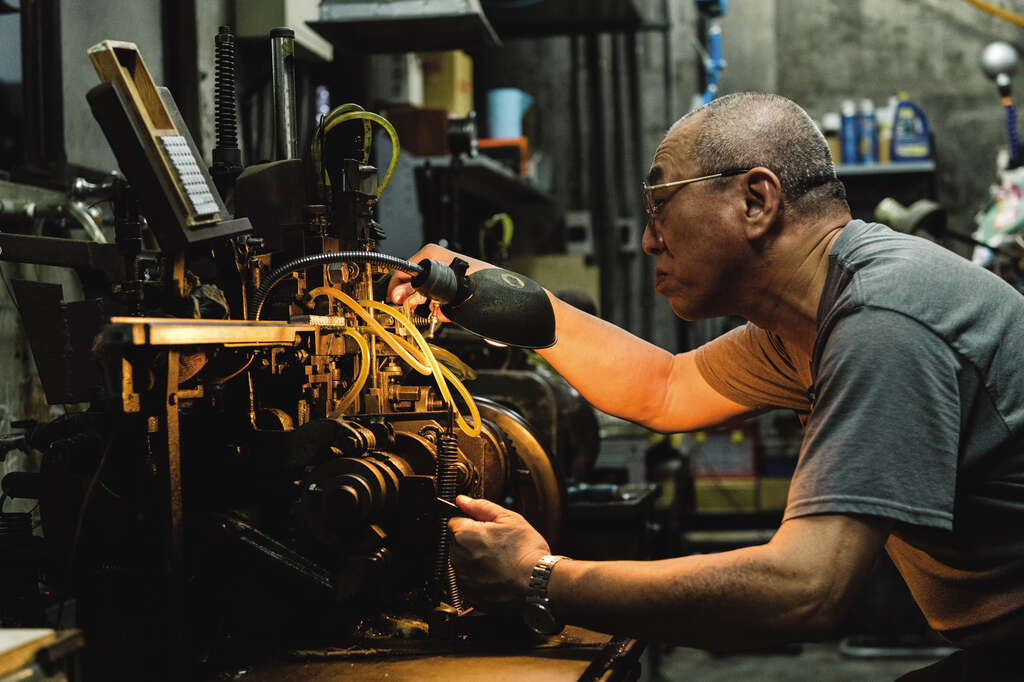 ▲Master Zhang demonstrates how to create lead character types with the specialized machine.
▲Master Zhang demonstrates how to create lead character types with the specialized machine.
THE PEAK OF THE INDUSTRY
The name “Ri Xing (日星),” when broken down into three individual Chinese characters, actually means “efficient and prosperous every day (日日生).” Zhang and his family are certainly a testament to that. At the height of the industry, he and his father would alternate between 12+ hour work shifts cranking out customer orders. “At the beginning, we couldn’t even afford a motorcycle,” he recalls. “So, to deliver orders, I’d bike 200 kilometers from Taipei south to Hsinchu (新竹) or north to Keelung (基隆) carrying 100 to 200 kilograms of boxes containing lead type on the back of my bike. I couldn’t even make it up or down Taipei Bridge (台北大橋) without having to get off and walk my bike halfway because it was so heavy!” Zhang now chuckles at the arduous memory.
Starting off as a small family business, he and his father would cast lead type, while his sister would pick out words for client orders and his mother would handle accounting. They eventually grew to 30 employees at the business’s peak, which at the time was still small, considering other companies in Taipei had nearly 200 employees. This would later prove to their advantage as many of the larger type foundries were unable to withstand the pressure of the digital era and the introduction of computer printing around the turn of the new millennium due to the burden of personnel costs.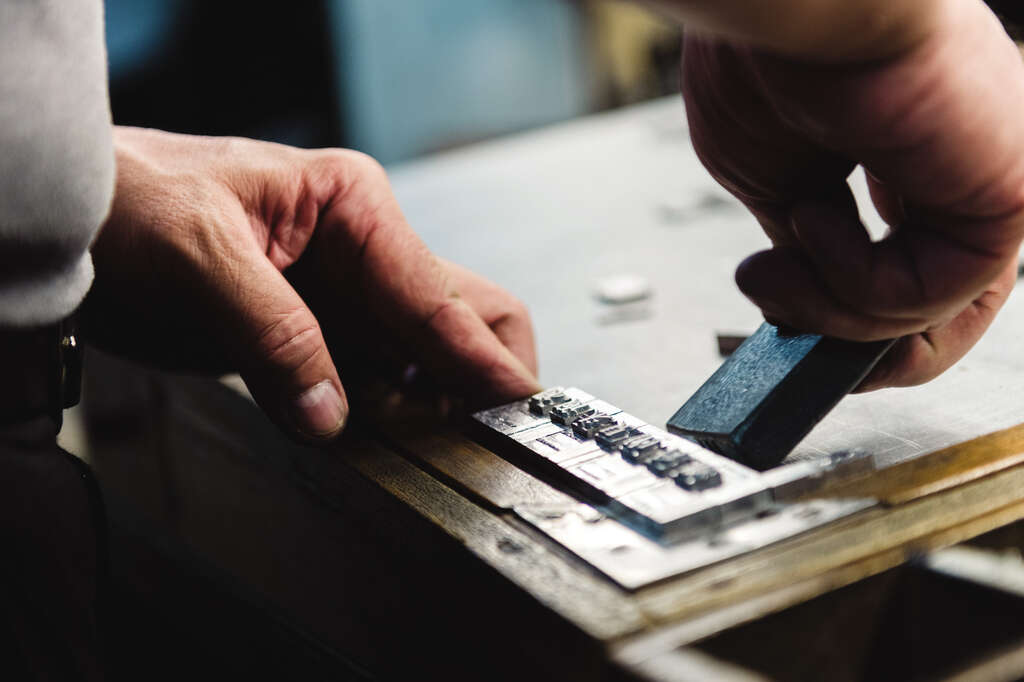 ▲As the digital era continues, letterpress printing has gradually become a forgotten area of expertise.
▲As the digital era continues, letterpress printing has gradually become a forgotten area of expertise.
HISTORY OF TAIPEI & RI XING
Tracing further back to the Japanese era, the Wanhua District of Taipei was and still is the heart of Taiwan’s largest newspaper publishers. Ri Xing lies at the outskirts of the district, located between the borders of Wanhua and Dadaocheng. “My father had just founded the company after going his separate way from a business partner, so he had limited funds to set up shop at the time,” Zhang recalls, “But we were located right behind Taipei Main Station, which gave us an edge over the other type foundries at the time.”
However, over the course of the past two decades, Zhang has inevitably seen his share of change in the culture and landscape of the city. Speaking of his thoughts on Taipei now, he tells us, “Taipei is similar to the Chinese character ‘化 (Hua).’ There is balance in the word itself because it can stand alone to mean ‘people (亻)’ and ‘compare or contradistinction (匕).’ When you put them back together it means ‘change (化).’ It’s the ‘people’s contradistinction’ which makes Taipei an everchanging city. It might be a little messy, yet there exists some level of structure within the mess.” And when asked how he would sum up Taipei in one line, he smiles with pride. “I would say: ‘The hidden gem and beauty of Chinese characters lies right in the heart of Taipei (漢字之美在台北).’ That’s how I would want locals and foreigners alike to experience Ri Xing and Taipei.”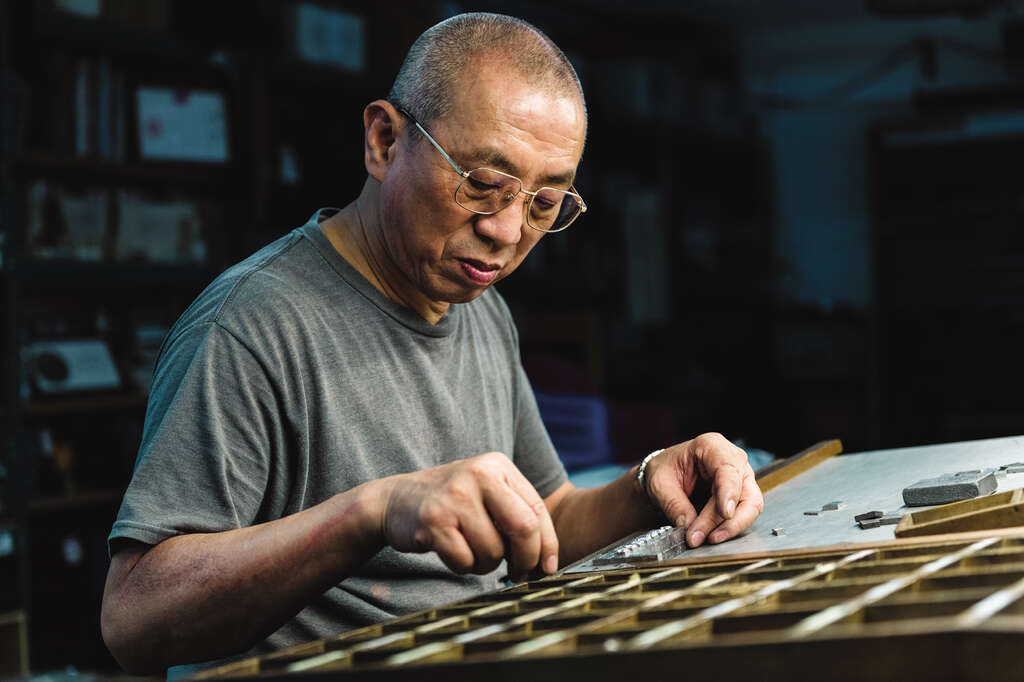 ▲Nowadays, Master Zhang is one of a few of the craftsmen who are still familiar with movable type.
▲Nowadays, Master Zhang is one of a few of the craftsmen who are still familiar with movable type.
THE DECLINE OF AN INDUSTRY AND TRANSFORMATION
As a machinery enthusiast, Zhang recalls, “I needed to buy some components for a speaker I was building. And just around the corner on Zhonghua Road, I saw the brand-new Apple II computer in the window. I knew right then and there the future of letterpress printing would take a different turn, not just in Taipei but also in the world.” He wasn’t wrong. By 1995, the world was obsessed with typography on a different scale — a digital one. And by 2005, a mere ten years later, after the other two remaining type foundry shops closed down in Taipei, Ri Xing was the last one standing. “I knew it would be selfish of me to close down as well. It would have inevitably sealed the fate for Traditional Chinese letterpress printing and Traditional Chinese type foundry as a whole,” he recalls.
So, in 2005, against the wishes of his family, he decided to re-establish Ri Xing as an arts and handicrafts institution instead, preserving the last traditional Chinese type foundry in the world. “I wanted to be sure this was something that wasn’t read about only in textbooks. It needed to be a living technology you could still reach out and touch or feel, not observed from behind a dusty window pane in a museum.”
While other type foundries all over Europe have eventually found their way into museums, Ri Xing is still a living, breathing type foundry in Taipei — still creating new letterpress molds to this day. “We even made a Tibetan type set for the Dalai Lama a few years ago. It took us just under three months to complete,” Zhang smiles with pride. And there have been many Japanese visitors coming to Ri Xing to request certain Japanese lead character types, with their own molds and machinery no longer available.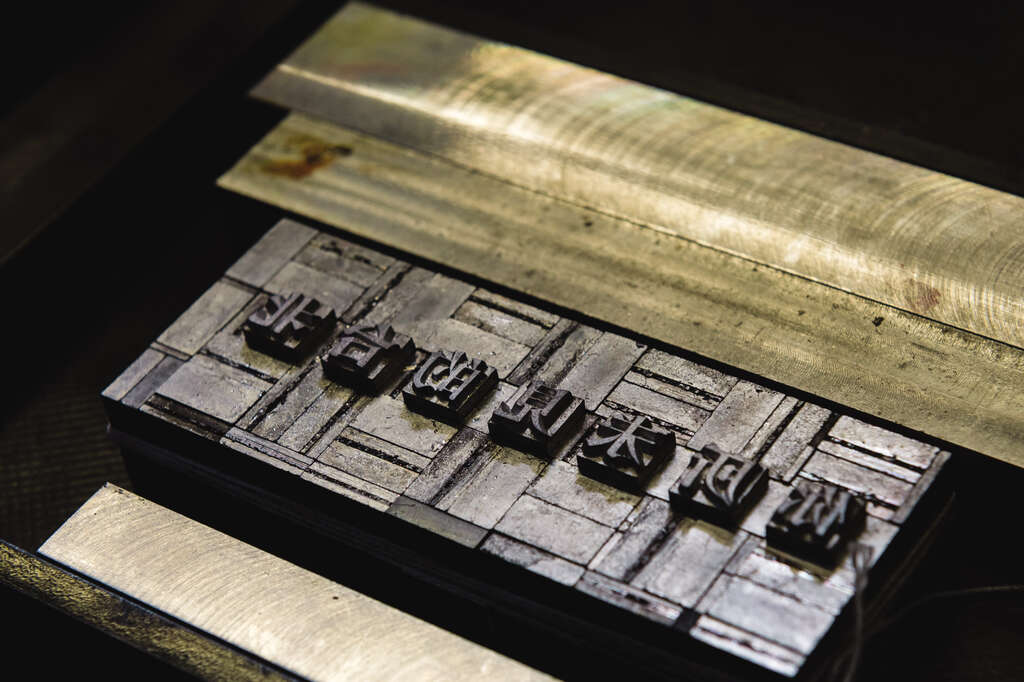 ▲One of the important steps of letterpress printing is to lock the movable type tightly into a “bed.”
▲One of the important steps of letterpress printing is to lock the movable type tightly into a “bed.”
RULES WHEN VISITING RI XING
There are a few rules when visiting Ri Xing: 1) Upon arrival, place all your belongings to the side of the entrance in the cubbies available (God forbid if you were to accidentally swing your bag and knock over an entire shelf!), and 2) If you pick up a letter type, you buy it. No exceptions.
Ri Xing is extremely rigorous about picking up words, but this particular rule is actually reflective of the entire industry as a whole. “My father worked in a printing press during the Martial Law era, and one of his colleagues went missing overnight when he accidentally added a single word to the press.” When asked which word was added, he replies, “He added ‘People (人)’ to the ‘Republic of China (中華民國),’ making it the ‘People’s Republic of China (中華人民國).’” Therefore, it’s safe to say Zhang has inherited the same diligence of his father’s time.
Upon picking your letter type, it’s simple: If you pick it up, you buy it. “It makes more sense economically for me to cast another ten words than for you to put it back,” he scoffs. “I have no doubt you can put it back in its correct place once. Even twice. But 10,000 times? Impossible.” And for a language that uses over 130,000 words on a daily basis, we surely can’t blame him.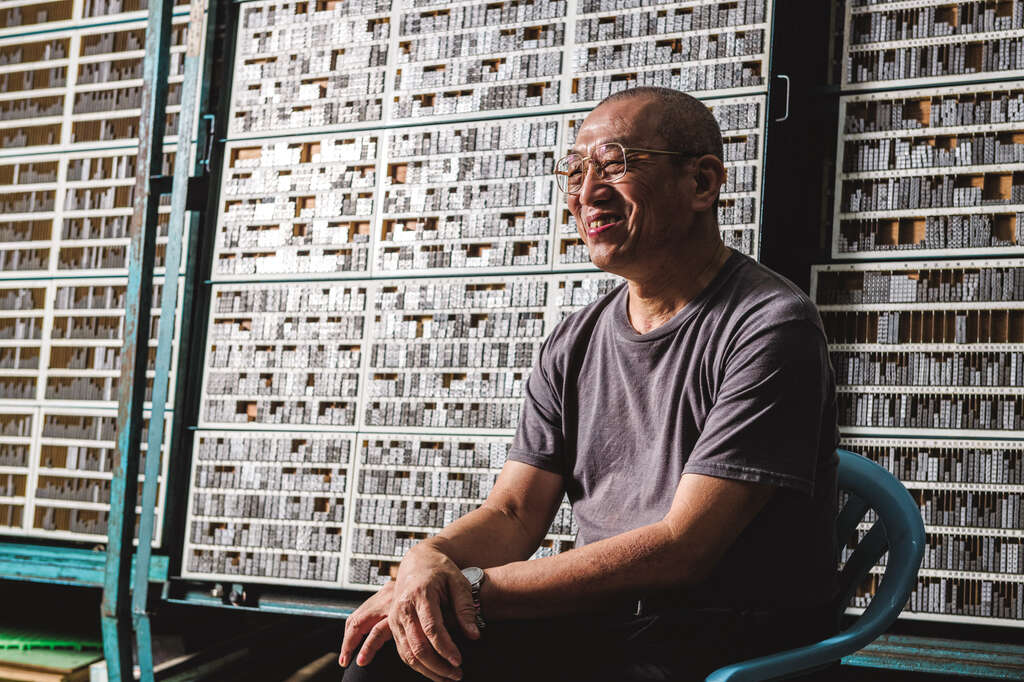 ▲As Ri Xing is turning into an arts and handicrafts institution, Master Zhang hopes that young people can come to learn about letterpress printing and leave feeling inspired to do more.
▲As Ri Xing is turning into an arts and handicrafts institution, Master Zhang hopes that young people can come to learn about letterpress printing and leave feeling inspired to do more.
THE FUTURE OF RI XING, A TAIPEI TREASURE
According to Zhang, “It takes double the time for any dying industry to be reborn again. More importantly, it needs young people and capital. And seeing that letterpress printing has been gone for 20 years now, this means it may take another 40 to 50 years for it to start up again.” Now as an arts and handicrafts institution, his hope is that young people can come to Ri Xing to learn about letterpress printing — and leave feeling inspired to do more. “We offer daily group tours and even educational courses on how to use the machines and letterpress,” Zhang encourages.
However, be advised that courses are offered primarily in Chinese, but foreign visitors who simply want to admire the beauty of Chinese characters are always welcome to Ri Xing to bring back a lead character type as a souvenir, as finding the character you want from the rack could always be a fun and enjoyable experience.
Preserving traditional Chinese characters has never been an easy task, and the mission has become even harder for Ri Xing when Zhang decided to carry on with a dying industry. While the world moves on rapidly as the digital era continues, we know that Zhang and Ri Xing will still start the fire every day to cast the memory of the last generation in Taipei.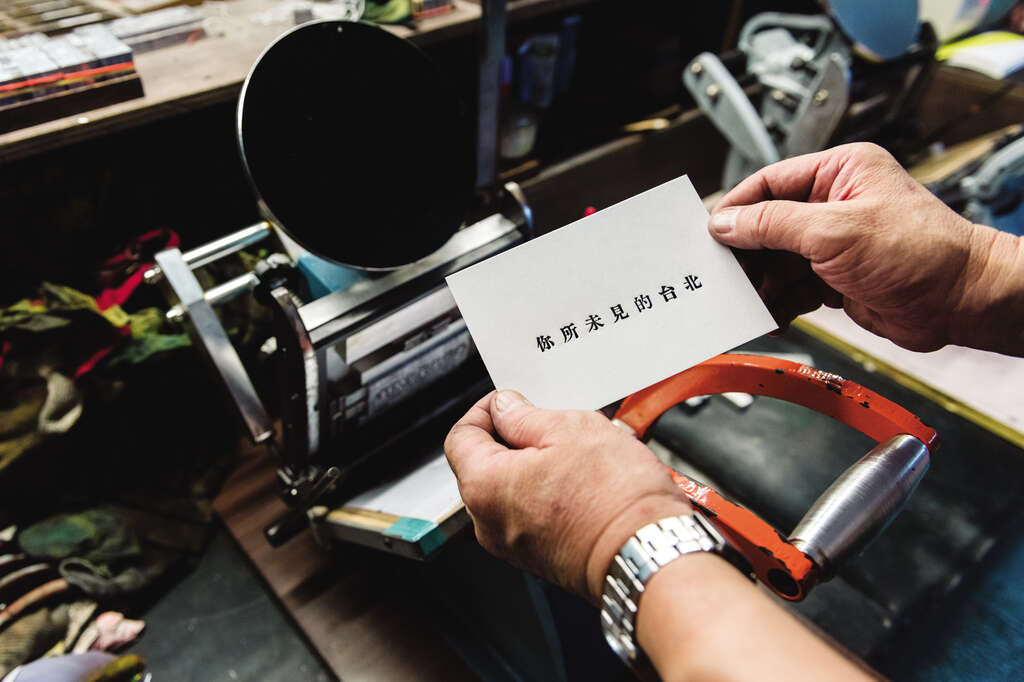 ▲Master Zhang printed out 7 Chinese characters “ 你所未見的台北 ” for TAIPEI, meaning “undiscovered Taipei.”
▲Master Zhang printed out 7 Chinese characters “ 你所未見的台北 ” for TAIPEI, meaning “undiscovered Taipei.”
Ri Xing Type Foundry: Fresh Impressions of a Fading Legacy
Words by Catherine Shin
Photos by Yi Choon Tang
Located on a quiet alley off a bustling street near Taipei Main Station lies a storefront that looks largely untouched since the 1960s, Ri Xing Type Foundry (日星鑄字行). The owner, Zhang Jieguan (張介冠), cheerfully appears at the door, probably accustomed to having visitors walk right up to the entrance out of sheer curiosity. He welcomes TAIPEI in, and immediately we stand at the door gaping at towering aisle after aisle of Chinese lead type characters awaiting us inside. Every Chinese character you could ever imagine has been packed tightly in neatly-stacked rows based on radicals (部首) or common phrases. And as if the first floor wasn’t astounding enough, we follow Zhang down the steps leading to a basement filled with yet even more rows of lead type characters. What is this place and how did Zhang singlehandedly bear such a large undertaking?

▲When you enter Ri Xing Type Foundry, the first thing that comes into view are the lead character types packed tight in neatly-stacked rows.
A FADING TRADITION STANDING STILL IN TAIPEI
The origins of letterpress printing can actually be traced as far back as the mid-15th century in Germany to Johannes Gutenberg. At a time when all manuscripts were written painstakingly by hand, letterpress printing was an efficient form of printing that could produce as much as six pages a day. By locking movable type into a “bed” and adding a layer of ink, the ink from the type would be pressed firmly onto the sheet of paper, leaving a deep impression of words on the sheet. Not only did this technology pave the way for the future of computer printing, but it also made information more accessible to a wider audience at the time. The letterpress printing industry thrived in Taipei from the 1950s and supported a then blooming publishing industry, witnessing the rise of the Economic Miracle period in Taiwan.
Although a late player to the game — Ri Xing was established in 1969 near the tail end of the industry’s peak — today it is arguably the last standing Traditional Chinese type foundry in the entire world. Having seen shop after shop close down in the early 2000s, Zhang bravely made up his mind to keep his shop going, not wanting to see this traditional method of letterpress printing die out. But for a language like Chinese with over 50,000 characters, this unprecedented, almost unheard-of scale is one even Gutenberg himself could never have imagined!
 ▲After the temperature reaches 300 degrees Celsius, the machine then cranks out 10 characters at a time.
▲After the temperature reaches 300 degrees Celsius, the machine then cranks out 10 characters at a time. HOW LEAD CHARACTER TYPES ARE CAST
In order to create lead character types, lead must be added to a heated pot in a machine, boiled to 300 degrees Celsius, and then released using a plunger that forces the liquid metal into a mold, casting the correct character. The machine Zhang demonstrates for us cranks out 10 characters at a time. Just how heavy can these characters get? “Well, lead is 13.6 times heavier than water. So, for the largest character, it’s about 20 characters per kilogram. And for the smallest one, it’s about 644 characters,” Zhang replies matter-of-factly.
In terms of Chinese typefaces, Ri Xing produces only three kinds: Kaiti (楷體), Songti (宋體), and Heiti (黑體). But don’t be fooled. Each typeface set consists of ten sizes, multiplied by over 13,000 characters each — meaning each individual typeface set contains over 130,000 characters. Imagine having to pick out a single character from over 130,000 choices! Add into the mix Japanese and English letter types, with most containing more than one copy, and you’ve easily got more than 10 million lead character types available for printing or sale at any given time.
 ▲Master Zhang demonstrates how to create lead character types with the specialized machine.
▲Master Zhang demonstrates how to create lead character types with the specialized machine.THE PEAK OF THE INDUSTRY
The name “Ri Xing (日星),” when broken down into three individual Chinese characters, actually means “efficient and prosperous every day (日日生).” Zhang and his family are certainly a testament to that. At the height of the industry, he and his father would alternate between 12+ hour work shifts cranking out customer orders. “At the beginning, we couldn’t even afford a motorcycle,” he recalls. “So, to deliver orders, I’d bike 200 kilometers from Taipei south to Hsinchu (新竹) or north to Keelung (基隆) carrying 100 to 200 kilograms of boxes containing lead type on the back of my bike. I couldn’t even make it up or down Taipei Bridge (台北大橋) without having to get off and walk my bike halfway because it was so heavy!” Zhang now chuckles at the arduous memory.
Starting off as a small family business, he and his father would cast lead type, while his sister would pick out words for client orders and his mother would handle accounting. They eventually grew to 30 employees at the business’s peak, which at the time was still small, considering other companies in Taipei had nearly 200 employees. This would later prove to their advantage as many of the larger type foundries were unable to withstand the pressure of the digital era and the introduction of computer printing around the turn of the new millennium due to the burden of personnel costs.
 ▲As the digital era continues, letterpress printing has gradually become a forgotten area of expertise.
▲As the digital era continues, letterpress printing has gradually become a forgotten area of expertise.HISTORY OF TAIPEI & RI XING
Tracing further back to the Japanese era, the Wanhua District of Taipei was and still is the heart of Taiwan’s largest newspaper publishers. Ri Xing lies at the outskirts of the district, located between the borders of Wanhua and Dadaocheng. “My father had just founded the company after going his separate way from a business partner, so he had limited funds to set up shop at the time,” Zhang recalls, “But we were located right behind Taipei Main Station, which gave us an edge over the other type foundries at the time.”
However, over the course of the past two decades, Zhang has inevitably seen his share of change in the culture and landscape of the city. Speaking of his thoughts on Taipei now, he tells us, “Taipei is similar to the Chinese character ‘化 (Hua).’ There is balance in the word itself because it can stand alone to mean ‘people (亻)’ and ‘compare or contradistinction (匕).’ When you put them back together it means ‘change (化).’ It’s the ‘people’s contradistinction’ which makes Taipei an everchanging city. It might be a little messy, yet there exists some level of structure within the mess.” And when asked how he would sum up Taipei in one line, he smiles with pride. “I would say: ‘The hidden gem and beauty of Chinese characters lies right in the heart of Taipei (漢字之美在台北).’ That’s how I would want locals and foreigners alike to experience Ri Xing and Taipei.”
 ▲Nowadays, Master Zhang is one of a few of the craftsmen who are still familiar with movable type.
▲Nowadays, Master Zhang is one of a few of the craftsmen who are still familiar with movable type.THE DECLINE OF AN INDUSTRY AND TRANSFORMATION
As a machinery enthusiast, Zhang recalls, “I needed to buy some components for a speaker I was building. And just around the corner on Zhonghua Road, I saw the brand-new Apple II computer in the window. I knew right then and there the future of letterpress printing would take a different turn, not just in Taipei but also in the world.” He wasn’t wrong. By 1995, the world was obsessed with typography on a different scale — a digital one. And by 2005, a mere ten years later, after the other two remaining type foundry shops closed down in Taipei, Ri Xing was the last one standing. “I knew it would be selfish of me to close down as well. It would have inevitably sealed the fate for Traditional Chinese letterpress printing and Traditional Chinese type foundry as a whole,” he recalls.
So, in 2005, against the wishes of his family, he decided to re-establish Ri Xing as an arts and handicrafts institution instead, preserving the last traditional Chinese type foundry in the world. “I wanted to be sure this was something that wasn’t read about only in textbooks. It needed to be a living technology you could still reach out and touch or feel, not observed from behind a dusty window pane in a museum.”
While other type foundries all over Europe have eventually found their way into museums, Ri Xing is still a living, breathing type foundry in Taipei — still creating new letterpress molds to this day. “We even made a Tibetan type set for the Dalai Lama a few years ago. It took us just under three months to complete,” Zhang smiles with pride. And there have been many Japanese visitors coming to Ri Xing to request certain Japanese lead character types, with their own molds and machinery no longer available.
 ▲One of the important steps of letterpress printing is to lock the movable type tightly into a “bed.”
▲One of the important steps of letterpress printing is to lock the movable type tightly into a “bed.” RULES WHEN VISITING RI XING
There are a few rules when visiting Ri Xing: 1) Upon arrival, place all your belongings to the side of the entrance in the cubbies available (God forbid if you were to accidentally swing your bag and knock over an entire shelf!), and 2) If you pick up a letter type, you buy it. No exceptions.
Ri Xing is extremely rigorous about picking up words, but this particular rule is actually reflective of the entire industry as a whole. “My father worked in a printing press during the Martial Law era, and one of his colleagues went missing overnight when he accidentally added a single word to the press.” When asked which word was added, he replies, “He added ‘People (人)’ to the ‘Republic of China (中華民國),’ making it the ‘People’s Republic of China (中華人民國).’” Therefore, it’s safe to say Zhang has inherited the same diligence of his father’s time.
Upon picking your letter type, it’s simple: If you pick it up, you buy it. “It makes more sense economically for me to cast another ten words than for you to put it back,” he scoffs. “I have no doubt you can put it back in its correct place once. Even twice. But 10,000 times? Impossible.” And for a language that uses over 130,000 words on a daily basis, we surely can’t blame him.
 ▲As Ri Xing is turning into an arts and handicrafts institution, Master Zhang hopes that young people can come to learn about letterpress printing and leave feeling inspired to do more.
▲As Ri Xing is turning into an arts and handicrafts institution, Master Zhang hopes that young people can come to learn about letterpress printing and leave feeling inspired to do more.THE FUTURE OF RI XING, A TAIPEI TREASURE
According to Zhang, “It takes double the time for any dying industry to be reborn again. More importantly, it needs young people and capital. And seeing that letterpress printing has been gone for 20 years now, this means it may take another 40 to 50 years for it to start up again.” Now as an arts and handicrafts institution, his hope is that young people can come to Ri Xing to learn about letterpress printing — and leave feeling inspired to do more. “We offer daily group tours and even educational courses on how to use the machines and letterpress,” Zhang encourages.
However, be advised that courses are offered primarily in Chinese, but foreign visitors who simply want to admire the beauty of Chinese characters are always welcome to Ri Xing to bring back a lead character type as a souvenir, as finding the character you want from the rack could always be a fun and enjoyable experience.
Preserving traditional Chinese characters has never been an easy task, and the mission has become even harder for Ri Xing when Zhang decided to carry on with a dying industry. While the world moves on rapidly as the digital era continues, we know that Zhang and Ri Xing will still start the fire every day to cast the memory of the last generation in Taipei.
 ▲Master Zhang printed out 7 Chinese characters “ 你所未見的台北 ” for TAIPEI, meaning “undiscovered Taipei.”
▲Master Zhang printed out 7 Chinese characters “ 你所未見的台北 ” for TAIPEI, meaning “undiscovered Taipei.”Gallery
:::
Popular articles
 TAIPEI Quarterly 2019 Winter Vol.18
TAIPEI Quarterly 2019 Winter Vol.18 Celebrating Lunar New Year in Taipei: A Guide to Proper Etiquette (TAIPEI Quarterly 2019 Winter Vol.18)
Celebrating Lunar New Year in Taipei: A Guide to Proper Etiquette (TAIPEI Quarterly 2019 Winter Vol.18) Everything Is Illuminated — Taipei During the Lantern Festival (TAIPEI Quarterly 2019 Winter Vol.18)
Everything Is Illuminated — Taipei During the Lantern Festival (TAIPEI Quarterly 2019 Winter Vol.18) Rui-Cheng Embroidered Red Calabash Passed down Through Five Generations of Warm Winter (TAIPEI Quarterly 2019 Winter Vol.18)
Rui-Cheng Embroidered Red Calabash Passed down Through Five Generations of Warm Winter (TAIPEI Quarterly 2019 Winter Vol.18) Handmade Tangyuan — Every One a Treasure unto Its Own (TAIPEI Quarterly 2019 Winter Vol.18)
Handmade Tangyuan — Every One a Treasure unto Its Own (TAIPEI Quarterly 2019 Winter Vol.18) Warming, Hearty, Comforting Year-End Hot Pot Gatherings (TAIPEI Quarterly 2019 Winter Vol.18)
Warming, Hearty, Comforting Year-End Hot Pot Gatherings (TAIPEI Quarterly 2019 Winter Vol.18)
 Ri Xing Type Foundry: Fresh Impressions of a Fading Legacy (TAIPEI Quarterly 2019 Winter Vol.18)
Ri Xing Type Foundry: Fresh Impressions of a Fading Legacy (TAIPEI Quarterly 2019 Winter Vol.18)